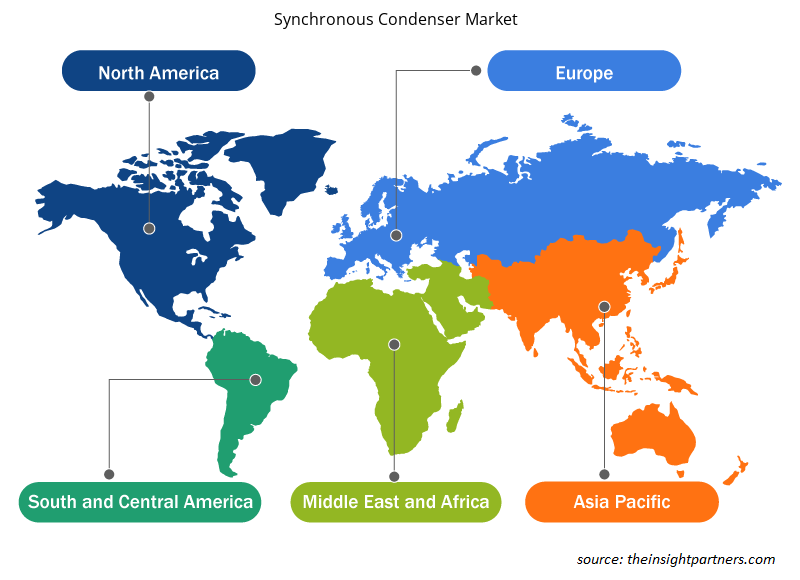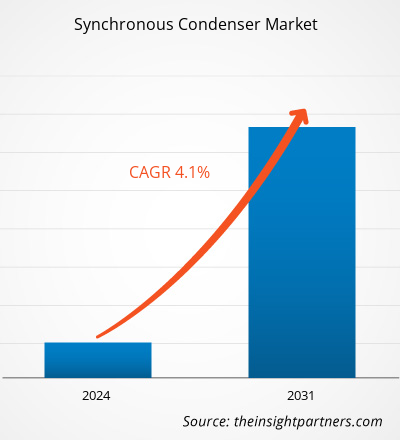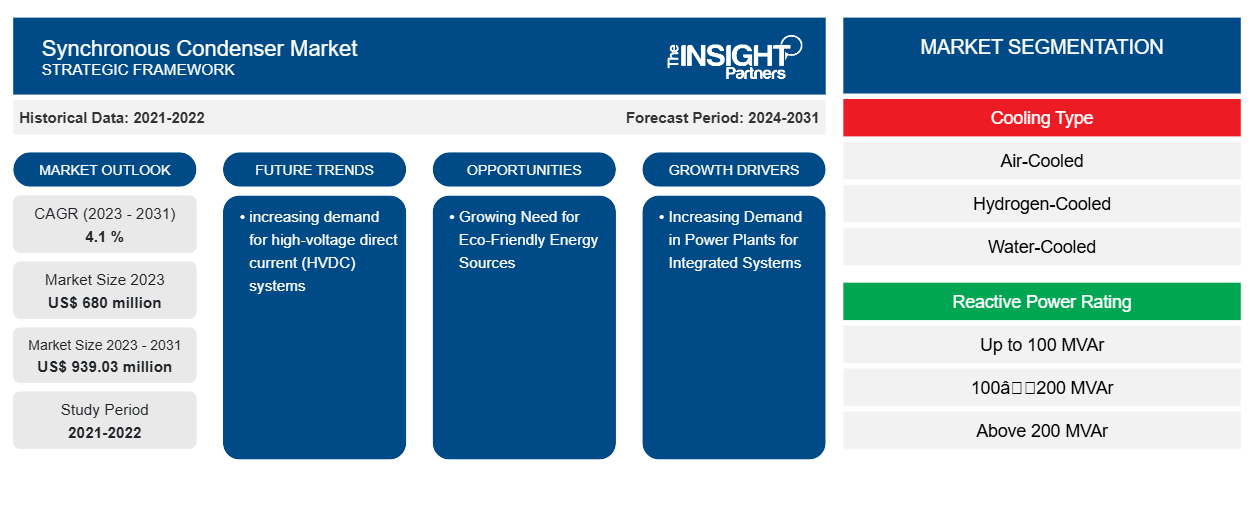Der Markt für Synchronkondensatoren soll von 680 Millionen US-Dollar im Jahr 2023 auf 939,03 Millionen US-Dollar im Jahr 2031 anwachsen. Der Markt soll in den Jahren 2023–2031 eine durchschnittliche jährliche Wachstumsrate von 4,1 % verzeichnen. Die steigende Nachfrage nach Hochspannungs-Gleichstrom-Übertragungssystemen (HGÜ) dürfte ein wichtiger Trend auf dem Markt für Synchronkondensatoren bleiben.
Synchronkondensator Marktanalyse
Der wachsende Bedarf an nachhaltigen Energiequellen treibt den Markt für Synchronkondensatoren weltweit stark voran. Der Markt wächst teilweise aufgrund des steigenden Bedarfs der Kraftwerke an integrierten Systemen. Eine wichtige Chance in diesem Zusammenhang ist die Zunahme staatlicher Programme zur Verringerung der Luftverschmutzung. Der Markt wird jedoch durch Faktoren wie erhöhte Kapital- und Wartungskosten und strenge Vorschriften für Synchronkondensatoren eingeschränkt. Zu den Schwierigkeiten gehören das Vorhandensein kostengünstiger Alternativen und die Notwendigkeit eines komplizierten und langwierigen Installationsverfahrens.
Marktübersicht für Synchronkondensatoren
Synchronkondensatoren sind gleichstromerregte Synchronmotoren, die ihre Leistung und Temperatur entsprechend dem Stromübertragungsnetz verändern. Der Zweck von Synchronkompensatoren, auch Synchronkondensatoren genannt, besteht darin, den Spannungspegel in einem Netzbereich kontinuierlich zu regeln. Abhängig vom Erregerstromwert können sie Blindleistung erzeugen oder verbrauchen. Wenn es um die Leistungsfaktorkorrektur in Stromnetzen geht , bieten Synchronkondensatoren eine Alternative zu Kondensatorbänken.
Passen Sie diesen Bericht Ihren Anforderungen an
Sie erhalten kostenlose Anpassungen an jedem Bericht, einschließlich Teilen dieses Berichts oder einer Analyse auf Länderebene, eines Excel-Datenpakets sowie tolle Angebote und Rabatte für Start-ups und Universitäten.
- Holen Sie sich die wichtigsten Markttrends aus diesem Bericht.Dieses KOSTENLOSE Beispiel umfasst eine Datenanalyse von Markttrends bis hin zu Schätzungen und Prognosen.
Markttreiber und Chancen für Synchronkondensatoren
Steigende Nachfrage in Kraftwerken nach integrierten Systemen
Da das Bewusstsein für erneuerbare Energiequellen wächst, besteht ein wachsender Bedarf an Lösungen, die die Stromqualität und Netzstabilität verbessern können. In Stromsystemen sind Synchronkondensatoren unverzichtbar, da sie die Spannung regulieren und Blindleistung aufrechterhalten. Dank der Integration dieser Kondensatoren bleibt die allgemeine Zuverlässigkeit des Stromerzeugungs- und -verteilungsnetzes erhalten, der Kraftwerksbetrieb wird optimiert und Netzschwankungen werden reduziert. Da der Bedarf an Netzstabilität steigt, wird erwartet, dass der Einsatz von Synchronkondensatoren zunimmt und den Markt vorantreibt.
Wachsender Bedarf an umweltfreundlichen Energiequellen
Der Begriff „saubere Energie“ beschreibt Energie aus Quellen, die keine Luftschadstoffe ausstoßen. Strom aus Ressourcen, die ständig erneuert werden, wird als erneuerbare Energie bezeichnet. Diese nachhaltigen Energiequellen, zu denen Wind- und Sonnenenergie gehören, werden nicht wie fossile Brennstoffe und Gas ausgehen. Nachhaltige Energiequellen sind jedoch größtenteils erneuerbar. Daher sind erneuerbare Energiequellen ein anderer Name für makellose grüne, saubere Energie . Daher wird erwartet, dass der wachsende Bedarf an umweltfreundlichen Energiequellen den Akteuren auf dem Markt für Synchronkondensatoren im Prognosezeitraum neue Möglichkeiten bietet.eco-friendly energy sources is anticipated to present new opportunities for the synchronous condenser market players during the forecast period.
Segmentierungsanalyse des Marktberichts für Synchronkondensatoren
Wichtige Segmente, die zur Ableitung der Marktanalyse für Synchronkondensatoren beigetragen haben, sind Kühltyp, Blindleistungsbewertung, Startmethode und Anwendung.
- Basierend auf der Kühlart ist der Markt für Synchronkondensatoren in luftgekühlt, wasserstoffgekühlt und wassergekühlt unterteilt. Das wasserstoffgekühlte Segment hatte im Jahr 2023 einen größeren Marktanteil.
- Nach Blindleistungsbewertung ist der Markt in bis zu 100 MVAr, 100–200 MVAr und über 200 MVAr segmentiert.
- Nach Startmethode ist der Markt in Kleinmotoren, statische Frequenzumrichter und andere unterteilt.
- Nach Anwendung ist der Markt in Metall und Bergbau, Elektrizitätsversorgungsunternehmen und Netzbetreiber, Schifffahrt, Öl und Gas und Sonstige segmentiert.
Synchronkondensator Marktanteilsanalyse nach Geografie
Der geografische Umfang des Marktberichts für Synchronkondensatoren ist hauptsächlich in fünf Regionen unterteilt: Nordamerika, Asien-Pazifik, Europa, Naher Osten und Afrika sowie Südamerika/Süd- und Mittelamerika. In Bezug auf den Umsatz hatte Europa den größten Marktanteil bei Synchronkondensatoren. Hochspannungs-Gleichstrom-Übertragungssysteme (HGÜ), ein beträchtlicher Kundenstamm, das schnelle Wachstum der Branche für erneuerbare Energien und die Präsenz bedeutender regionaler Unternehmen sind dafür verantwortlich. Darüber hinaus wird erwartet, dass die Existenz von Ländern wie Deutschland, Großbritannien, Frankreich und Spanien die Expansion des europäischen Marktes unterstützen wird.
Regionale Einblicke in den Synchronkondensatormarkt
Die regionalen Trends und Faktoren, die den Markt für Synchronkondensatoren im Prognosezeitraum beeinflussen, wurden von den Analysten von Insight Partners ausführlich erläutert. In diesem Abschnitt werden auch die Marktsegmente und die Geografie von Synchronkondensatoren in Nordamerika, Europa, im asiatisch-pazifischen Raum, im Nahen Osten und Afrika sowie in Süd- und Mittelamerika erörtert.

- Erhalten Sie regionale Daten zum Synchronkondensatormarkt
Umfang des Marktberichts über Synchronkondensatoren
| Berichtsattribut | Details |
|---|---|
| Marktgröße im Jahr 2023 | 680 Millionen US-Dollar |
| Marktgröße bis 2031 | 939,03 Millionen US-Dollar |
| Globale CAGR (2023 - 2031) | 4,1 % |
| Historische Daten | 2021-2022 |
| Prognosezeitraum | 2024–2031 |
| Abgedeckte Segmente | Nach Kühlart
|
| Abgedeckte Regionen und Länder | Nordamerika
|
| Marktführer und wichtige Unternehmensprofile |
|
Marktteilnehmerdichte: Der Einfluss auf die Geschäftsdynamik
Der Markt für Synchronkondensatoren wächst rasant, angetrieben durch die steigende Nachfrage der Endnutzer aufgrund von Faktoren wie sich entwickelnden Verbraucherpräferenzen, technologischen Fortschritten und einem größeren Bewusstsein für die Vorteile des Produkts. Mit steigender Nachfrage erweitern Unternehmen ihr Angebot, entwickeln Innovationen, um die Bedürfnisse der Verbraucher zu erfüllen, und nutzen neue Trends, was das Marktwachstum weiter ankurbelt.
Die Marktteilnehmerdichte bezieht sich auf die Verteilung von Firmen oder Unternehmen, die in einem bestimmten Markt oder einer bestimmten Branche tätig sind. Sie gibt an, wie viele Wettbewerber (Marktteilnehmer) in einem bestimmten Marktraum im Verhältnis zu seiner Größe oder seinem gesamten Marktwert präsent sind.
Die wichtigsten auf dem Markt für Synchronkondensatoren tätigen Unternehmen sind:
- ABB Ltd.
- BRUSH-Gruppe
- Eaton Corporation PLC
- Fuji Electric Co., Ltd.
- Allgemeine Elektrik
- Hyundai Idela Electric Co.
Haftungsausschluss : Die oben aufgeführten Unternehmen sind nicht in einer bestimmten Reihenfolge aufgeführt.

- Erhalten Sie einen Überblick über die wichtigsten Akteure auf dem Markt für Synchronkondensatoren
Nachrichten und aktuelle Entwicklungen zum Synchronkondensatormarkt
Der Markt für Synchronkondensatoren wird durch die Erhebung qualitativer und quantitativer Daten nach Primär- und Sekundärforschung bewertet, die wichtige Unternehmensveröffentlichungen, Verbandsdaten und Datenbanken umfasst. Im Folgenden finden Sie eine Liste der Entwicklungen auf dem Markt für Sprach- und Sprechstörungen und Strategien:
- Im November 2023 stellte Siemens an der Shannon Bridge B in Irland ein hybrides Netzstabilisierungssystem vor. Dieses neuartige Gerät kombiniert eine 160-MWh-Batterie mit einem mit Schwungrad ausgestatteten Synchronkondensator. Dies ist das erste Mal, dass diese beiden Technologien kombiniert wurden, um eine einzige, zusammenhängende Netzanschlusslösung bereitzustellen. Die Verbesserung der Netzstabilität und die Optimierung der Nutzung erneuerbarer Energiequellen sind die Hauptziele. Siemens hofft, Netzprobleme erfolgreich zu bewältigen und den Übergang zu einer nachhaltigeren Energieinfrastruktur durch den Einsatz dieser hochmodernen Hybridlösung zu beschleunigen. (Quelle: Siemens, Pressemitteilung)
- Im November 2023 gab General Electric bekannt, dass EDF SEI ein Konsortium aus der Abteilung Power Conversion von GE Vernova und Eiffage Énergie Systèmes (Konsortialführer) ausgewählt hat, um ein schlüsselfertiges Synchronkondensatorsystem für die EDF bereitzustellen und zu bauen. (Quelle: General Electric, Pressemitteilung)
Marktbericht zu Synchronkondensatoren – Abdeckung und Ergebnisse
Der Bericht „Marktgröße und Prognose für Synchronkondensatoren (2021–2031)“ bietet eine detaillierte Analyse des Marktes, die die folgenden Bereiche abdeckt:
- Marktgröße und Prognose auf globaler, regionaler und Länderebene für alle wichtigen Marktsegmente, die im Rahmen des Projekts abgedeckt sind
- Marktdynamik wie Treiber, Beschränkungen und wichtige Chancen
- Wichtige Zukunftstrends
- Detaillierte PEST/Porters Five Forces- und SWOT-Analyse
- Globale und regionale Marktanalyse mit wichtigen Markttrends, wichtigen Akteuren, Vorschriften und aktuellen Marktentwicklungen
- Branchenlandschaft und Wettbewerbsanalyse, einschließlich Marktkonzentration, Heatmap-Analyse, prominenten Akteuren und aktuellen Entwicklungen
- Detaillierte Firmenprofile
- Historische Analyse (2 Jahre), Basisjahr, Prognose (7 Jahre) mit CAGR
- PEST- und SWOT-Analyse
- Marktgröße Wert/Volumen – Global, Regional, Land
- Branchen- und Wettbewerbslandschaft
- Excel-Datensatz
Aktuelle Berichte
Erfahrungsberichte
Grund zum Kauf
- Fundierte Entscheidungsfindung
- Marktdynamik verstehen
- Wettbewerbsanalyse
- Kundeneinblicke
- Marktprognosen
- Risikominimierung
- Strategische Planung
- Investitionsbegründung
- Identifizierung neuer Märkte
- Verbesserung von Marketingstrategien
- Steigerung der Betriebseffizienz
- Anpassung an regulatorische Trends





















 Kostenlose Probe anfordern für - Markt für Synchronkondensatoren
Kostenlose Probe anfordern für - Markt für Synchronkondensatoren